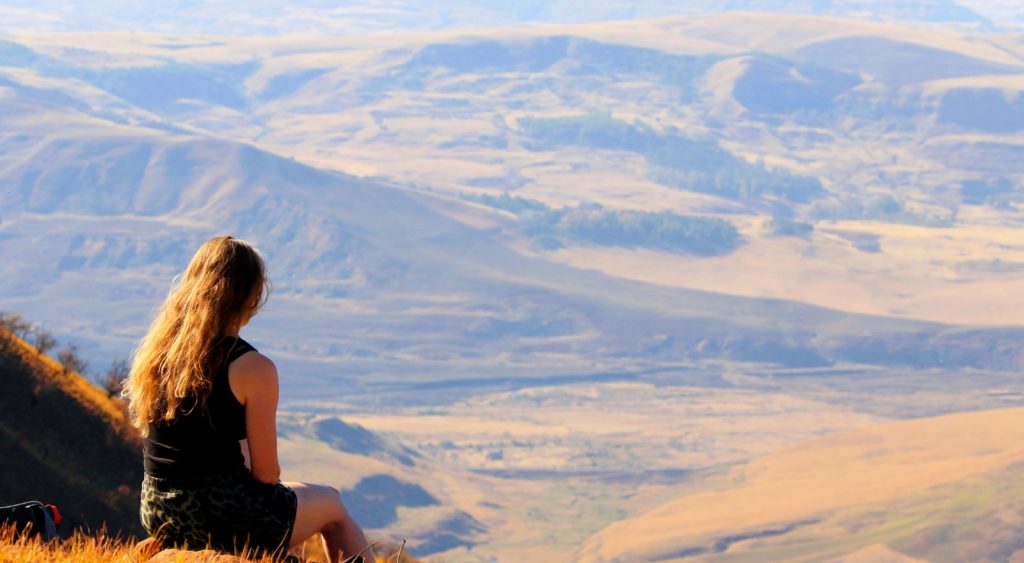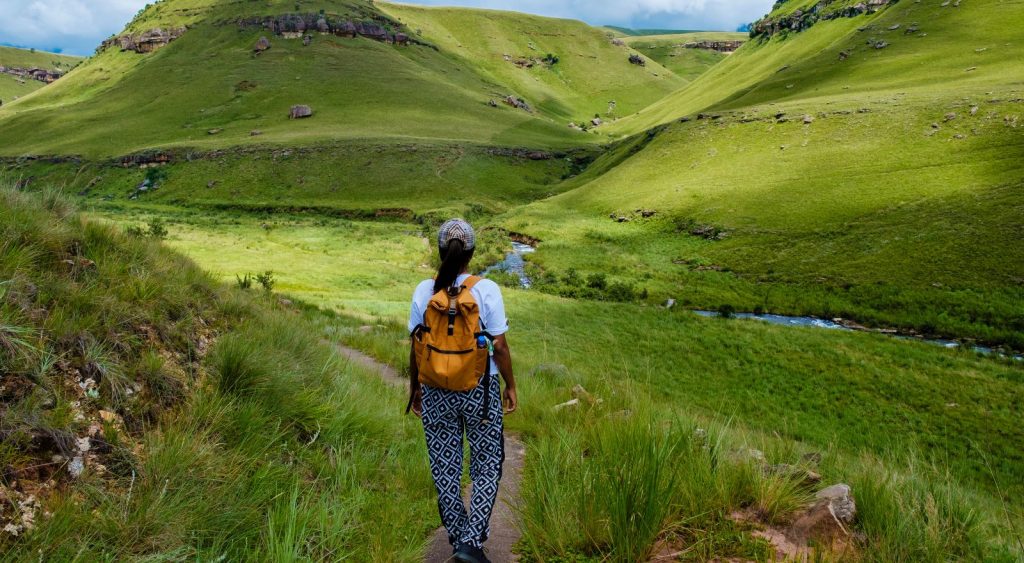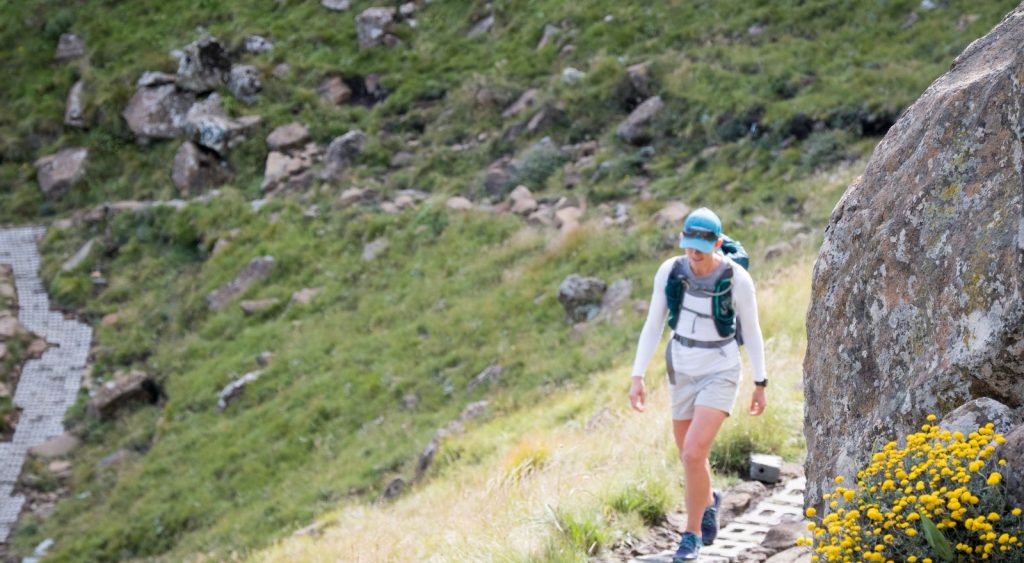The Drakensberg mountain range, straddling South Africa and Lesotho, is a captivating destination for hiking enthusiasts and nature lovers alike. Many travellers who visit here come for the exhilarating experience of hiking one of the world’s most picturesque mountain ranges.
If you too are dreaming of hiking in the Drakensberg keep reading as in this article we’ll address your frequently asked questions, offer practical tips, and highlighting important considerations such as safety, equipment, trail selection, wildlife encounters, weather conditions, and more. Whether you are a seasoned hiker or a novice explorer, after this quick read you’ll be equipped with the knowledge and confidence to embark on a memorable hiking journey in the majestic Drakensberg.

How to choose the right hiking trail for me?
The Drakensberg offers a wide range of hiking trails, catering to all skill levels and preferences. The Amphitheatre, Cathedral Peak, Monks’ Cowl Nature Reserve, and Giant’s Castle are some of the most popular areas, each offering their own network of trails with their own unique beauty and challenges.
The Royal Natal National Park which gives access to the Ampitheatre offers some of the most well-known and picturesque hikes in the Drakensberg but the least variety and is better for the more experienced. The area closest to Treks, Trips, and Trails, known as the Champagne Valley, offers the most in terms of trails, facilities and accommodation. Similar to this is Cathedral Peak and Giant’s Castle. Then there are outlying areas such as Injisuthi and Mnweni which offer only basic facilities and challenging hikes, but exquisite views.
When choosing a hiking trail in the Drakensberg, consider factors such as distance, elevation gain, difficulty level, and the time you have available. It’s also important to consider your own fitness level and experience. Starting with shorter and less challenging trails is a good option even if you are experienced due to the elevation and the fact that these beginner trails are well marked. Venture further afield and you can expect uneven terrain, unmarked trails, treacherous rivers and steep gradients. Remember, it’s not a race, so take your time and enjoy the journey at your own pace.
When is the best time to hike the Drakensberg?
The Drakensberg can be explored year-round, each season offering its own unique charm. Spring and autumn are popular choices due to milder temperatures and vibrant landscapes. The summer months are ideal for those who enjoy lush greenery and longer daylight hours, but be prepared for afternoon thunderstorms. Winter brings a different kind of beauty, with snow-capped peaks and fewer crowds, making it an excellent time for more experienced hikers seeking solitude. The weather in the Drakensberg can be unpredictable, so it’s crucial to prepare accordingly.
While hiking in the Drakensberg, it’s essential to be prepared for sudden weather changes and extreme conditions. Always carry adequate clothing layers, including waterproof gear, as rain showers can occur unexpectedly. UV protection is also crucial, as the high altitude can intensify the sun’s rays. Additionally, ensure you have sufficient food, water, and emergency supplies in case your hike takes longer than expected. Stay informed and flexible, adjusting your plans if weather conditions become unfavorable for your safety.

What equipment do I need for hiking in the Drakensberg?
When it comes to hiking in the Drakensberg, having the right gear is crucial. Some essentials include sturdy hiking boots, a backpack, a map or GPS device, a hat, sunscreen, and plenty of water and snacks. It’s also important to dress in layers to accommodate the changing weather conditions.
It’s important to pack light but smart. Remember to bring a first aid kit, extra socks, a rain jacket, insect repellent, and a headlamp. It’s always a good idea to check the weather forecast before you head out and pack accordingly.
What safety precautions should I take before hiking in the Drakensberg?
While hiking in the Drakensberg is a rewarding experience, it’s essential to be aware of the potential risks and dangers. These include unpredictable weather conditions, steep and rocky terrain, and the presence of wildlife. Being prepared and cautious can go a long way in ensuring your safety.
In case of emergencies, it’s important to have a plan in place. Make sure to inform someone about your hiking plans and estimated return time. Carry a fully charged cellphone and a whistle to attract attention if needed. Familiarize yourself with emergency procedures and know how to use any safety equipment you bring along. Make sure to save the number +27 800 005133 into your phone – this is the number for mountain rescue in Kwazulu Natal and is who you need to call in case of a serious emergency.
To stay safe while hiking in the Drakensberg, it’s crucial to stick to marked trails, hike with a partner or in a group whenever possible, and avoid hiking in bad weather conditions.
What can I see while hiking in the Drakensberg?
The Drakensberg is an area not only known for its breathtaking landscapes, vistas and waterfalls, but also for its unique rock art and rich biodiversity. As you hike through its trails, you’ll have the opportunity to encounter a diverse range of flora and fauna. From colorful wildflowers and rare proteas to unique bird species and elusive mammals, the Drakensberg is a nature lover’s paradise. Keep your eyes peeled and your camera ready as you may spot the likes of the graceful klipspringer, the elusive mountain reedbuck, or even the endangered bearded vulture soaring above.
While enjoying the wonders of the Drakensberg, it’s important to maintain responsible hiking practices to ensure the conservation of its wildlife. Stick to designated trails to minimise disturbance to natural habitats, avoid littering, and respect any signage regarding protected areas or restricted access. Remember, you’re a guest in their home! By being mindful of your actions, you can help preserve the beauty and serenity of the Drakensberg for generations to come.
Also, keep a safe distance and observe wild animals from afar, never feed or approach them, and do not attempt to corner or provoke them. This is particularly true when encountering snakes of which the region has 25 species. Only four of those however pose a threat, the Berg Adder, Night Adder, Rinkhals and Puff Adder with the latter being the main cause of snake bite fatalities in South Africa. If you come across larger animals such as antelopes or baboons, give them ample space to move freely and avoid disrupting their natural behavior. Remember, your safety and the preservation of wildlife go hand in hand.

Are there overnight hiking options in the Drakensberg?
For those who crave an immersive experience in nature, overnight hiking in the Drakensberg is a popular choice. If you plan to embark on an overnight hike, be sure to check if reservations are required, especially during peak seasons, and familiarise yourself with the specific regulations and facilities of the hike you choose.
Do I need a permit for hiking in the Drakensberg?
Before you embark on the trail, it’s important to familiarise yourself with the necessary permits and regulations. Most hiking areas require permits or a day fee, which can be obtained from the relevant authorities or park offices upon entry.
Is it necessary to hire a guide for hiking in the Drakensberg?
While many trails in the Drakensberg can be done independently, hiring a guide can enhance your experience, especially if you’re unfamiliar with the area or want to learn more about the region’s history and wildlife. Guides can also provide valuable insights and ensure your safety on more challenging hikes and can supply porter services that can make it easier to complete challenging trails. To visit certain areas, such as the rock paintings located between Royal Natal and Bushman’s Neck you will need to go with an Amafa accredited guide. Here at Treks, Trips, and Trails we can recommend a specialised hiking guide that will cater to your needs and skill level.

